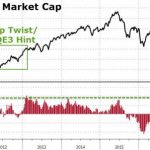Spreads Tighten But Retail Is Weak
Many investors are focused on the record highs in the S&P 500 and the Nasdaq and the VIX staying below 10 for another day, but I think the biggest story of Wednesday’s trading session is the tightening of bond spreads. As you can see from the chart below, the options adjusted spread for U.S. corporate BBB bonds reached a new cycle low. The spread fell to 1.41% which is below the tightest 2014 spread. This isn’t surprising because it has been flirting with this level for a few weeks. I think it’s justified based on the overall earnings situation despite the weakness in retail and energy. I have seen bears like Jonathan Tepper use this tight spread to make negative conclusions (he also mistakenly said it was the all-time low which isn’t true as you can see). This is a faulty conclusion if you look at the whole chart as the spread was tighter for many years without consequences in the 1990s and the 2000s.
Because this is a new cycle low which is the lowest in 10 years, it makes it look like this is a top signal. The reason it took this long to get to this level is because of the 2015-2016 earnings recession. It would be ridiculous to suggest that the great earnings reports in the past few quarters are somehow a negative. It might be years before the spread begins to widen again. This chart won’t tell you when a turn is coming as it reflects the changes in earnings. The way to project earnings changes is to see what the catalysts for sales growth are showing. The key point is that a wide spread doesn’t mean you should buy stocks and a tight spread doesn’t mean you should sell them. While it’s not a market timing device, it gives you a good idea whether investors are in risk on or risk off mode. It shows how stability in the junk bond market was much more common before the financial crisis, so you shouldn’t be worried about a calm environment leading to the next crisis.













Leave A Comment